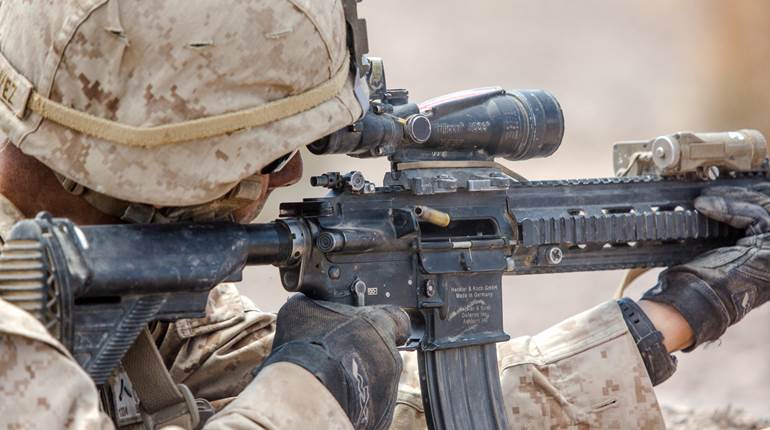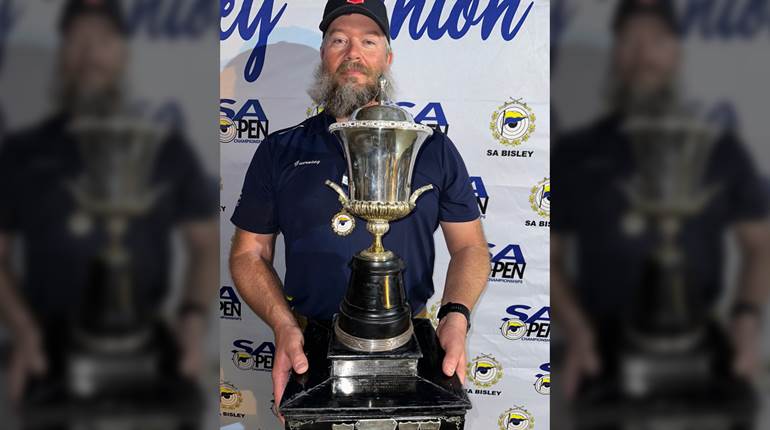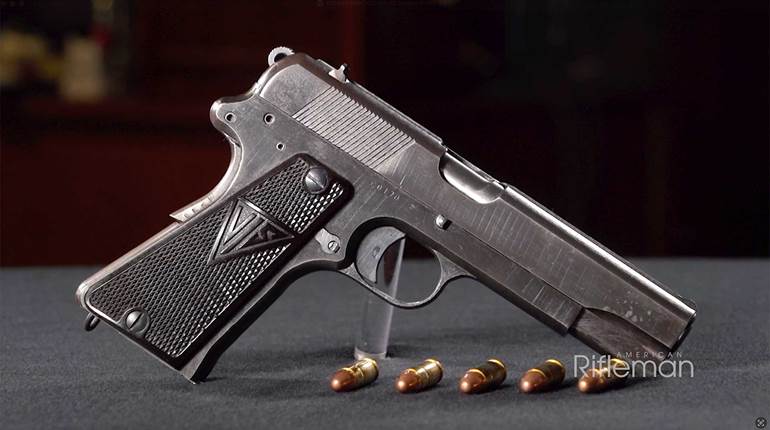
Of all the array of firearms in the hands of the Irish Republican Army (IRA) during the 1919-1921 Anglo-Irish War (or “Irish War of Independence”), the Canadian .303 Ross rifle is perhaps the oddest one in the IRA’s inventory. While there certainly were not many Ross rifles in the whole of Ireland, their proportions in the area of the Third (West Cork) Brigade’s area of operation is noteworthy, in that there apparently were more of them there than there were in any other part of the country. However, the contribution of the Ross rifle to Ireland’s successful bid for freedom from British rule is still cloaked in mystery.
 Although a very accurate rifle, the close tolerances and design of the Ross rifle made it prone to jamming, in the ubiquitous mud of the trenches in Flanders. By 1917, most of the Ross rifles had been withdrawn from the Canadian Expeditionary Force (CEF) and replaced with SMLE rifles. Courtesy of the author, photograph by Forrest MacCormack.
Although a very accurate rifle, the close tolerances and design of the Ross rifle made it prone to jamming, in the ubiquitous mud of the trenches in Flanders. By 1917, most of the Ross rifles had been withdrawn from the Canadian Expeditionary Force (CEF) and replaced with SMLE rifles. Courtesy of the author, photograph by Forrest MacCormack.
The story of the Canadian Ross rifle has been covered in several American Rifleman articles in recent years, most notably in those by Brian Sheetz (March 2010,) and by Bruce Canfield (May 2013), as well as in a recent (2018) “I Have This Old Gun” video on the American Rifleman website. Suffice to say, that, in spite of accolades bestowed on it by a few of the rifle’s modern-day shooters and admirers, the Ross rifle was seen as a liability in the hands of the Canadian Expeditionary Force (CEF)— and certainly in the eyes of those in authority— although it was useful as a sniper rifle.
The rifle was exceptionally accurate, but its “straight-pull” action was prone to jamming in the mud of Flanders, and, although this rarely happened, its bolt could be reassembled incorrectly— and with dire consequences. It was not a rifle that engendered a lot of trust from those who carried it, regardless of their patriotic pride in its being a “homegrown” Canadian design. By 1917, nearly all of the Canadian Ross rifles had been withdrawn from the infantry battalions of the CEF and then reissued to snipers, both Canadian and Allied, or relegated to rear area units.
 Ross rifles, most often with telescopic sights added, were issued not only to Canadian snipers, but also to other allied snipers, after 1916. Seen here is a sniper detachment from the Royal Irish Rifles, as depicted by modern-day historical interpreters. Courtesy of Jason Harris, photocomposition by Robert McDonough.
Ross rifles, most often with telescopic sights added, were issued not only to Canadian snipers, but also to other allied snipers, after 1916. Seen here is a sniper detachment from the Royal Irish Rifles, as depicted by modern-day historical interpreters. Courtesy of Jason Harris, photocomposition by Robert McDonough.
One of these “rear area units” was the Royal Navy, as rifles on board ship were not as critical as they were in the frontline trenches in France. Many of the Ross rifles replaced No.1 Mk III Short Magazine Lee-Enfield (SMLE) .303 rifles in the arms racks on British navy ships of all sorts and sizes, and the Enfields were sent to the front, enabling the Canadian infantry to replace their Ross rifles with Enfields. Six (some accounts say 10) of these Ross rifles found their way to the arms locker on a small motor launch (M.L. 171) which was patrolling Bantry Bay in the west of County Cork, at the southwestern most part of Ireland. The local Bantry battalion of the IRA knew that the rifles were aboard the launch (an 80-foot long gasoline-powered vessel, also referred to as a “sloop”) and they were in desperate need for arms. Indeed, the story of the Irish War of Independence hinges on the availability, and lack thereof, of firearms.
 The Ross rifles that were re-issued to the Royal Navy and Royal Marines usually bore their original Canadian unit markings. This rifle went overseas with the 29th Battalion CEF (“Tobin’s Tigers”) from Vancouver, British Columbia. Courtesy of the author, photograph by Forrest MacCormack.
The Ross rifles that were re-issued to the Royal Navy and Royal Marines usually bore their original Canadian unit markings. This rifle went overseas with the 29th Battalion CEF (“Tobin’s Tigers”) from Vancouver, British Columbia. Courtesy of the author, photograph by Forrest MacCormack.
Guns were far and few between in Ireland, and had been, since firearms had been invented. In years past, some large landlords kept armories full of military-style flintlocks and percussion guns (including a lot of blunderbusses) to defend against a “peasant” uprising, but, by the 20th century, most large estates only had a few sporting shotguns, or perhaps some big-game hunting rifles for trips abroad to Africa or Canada. A few small farmers had single- or double-barreled shotguns for small game hunting and varmints.
Aside from the SMLE rifles in the hands of British troops stationed at scattered posts throughout Ireland, there were only the shotguns in the hands of gentlemen (usually Loyalist) farmers, and the .303 Brit. P1905 carbines and .455 Webley revolvers carried by the paramilitary police force, the Royal Irish Constabulary (RIC.) According to a vignette in Rebel Cork’s Fighting Story, 1916-1921: As Told By The Men Who Made It, the three IRA brigades in County Cork numbered about 8,000 Volunteers, but only a handful of them were actually armed. Any guns, especially rifles of any sort in caliber .303 Brit., were desperately needed.
 Since rifles of any type were few and far between in Ireland in 1919, Ross rifles on board naval vessels in ports along the coast were tempting targets for the Irish Republican Army (IRA.) Courtesy of the author, photograph by Forrest MacCormack.
Since rifles of any type were few and far between in Ireland in 1919, Ross rifles on board naval vessels in ports along the coast were tempting targets for the Irish Republican Army (IRA.) Courtesy of the author, photograph by Forrest MacCormack.
On the night of Nov. 17, 1919, a small group of men from the Bantry’s 5th Battalion struck. They had been watching the activities of the motor launch closely for weeks, and timed their attack to coincide when the ship was tied up to the town’s dock for the night. After overpowering the guards, they successfully made off with the Ross rifles, some revolvers, and a large case of ammunition. The haul was subsequently turned over to the headquarters of the 3rd West Cork Brigade for appropriate distribution, after being secreted in a local church. According to the memoirs of the Brigade’s adjutant, Liam Deasy, the Canadian Ross rifles “were a welcome addition to the Brigade’s armament. Good use was made of them in many important engagements later in the war.”
 The rugged terrain of West Cork spreads beyond Bantry Bay, as seen here from a manor house overlooking the town and harbor below. This was the site of the IRA’s first haul of Ross rifles. Courtesy of the author, photograph by Linda Smith-Christmas.
The rugged terrain of West Cork spreads beyond Bantry Bay, as seen here from a manor house overlooking the town and harbor below. This was the site of the IRA’s first haul of Ross rifles. Courtesy of the author, photograph by Linda Smith-Christmas.
However, the IRA acquired more Ross rifles than this small lot at Bantry. Increasingly, the IRA had started attacking British government posts across Ireland (with what few guns they had commandeered, or captured from the police), and lighthouses and coastguard stations scattered at lonely spots along the shoreline were considered by the government to be likely targets. Accordingly, the decision was made to reinforce these coastal posts with Royal Marines, so the 8th “Special” Battalion of the Royal Marines was formed in June 1920, and drew Marines from several locations, including the Plymouth Division, Royal Marine Light Infantry (RMLI) at the British naval base in Plymouth, England.
The 8th Battalion spread out in small detachments along the west coast of Ireland, from Donegal in the north to Cork in the south. The IRA saw this action as more of an advantage than a problem, as, if these small isolated posts could be taken, this would be an excellent source for the badly needed .303 Brit. rifles. The IRA had discovered that coastguardsmen in these previously unarmed coastal installations (being “rear area units”) were now being issued Canadian Ross rifles. In his book, Towards Ireland Free, Deasy gives a good account of the decision to target these coastal stations in early July 1920, and then chronicles the successive attacks on them in West Cork.
 Those Ross rifles reissued to Royal Marines bore unit markings. This example was issued to the Royal Marine Light Infantry’s (RMLI) Plymouth (PLY) Division, stationed in Devon, England. Courtesy of the author, photograph by Forrest MacCormack.
Those Ross rifles reissued to Royal Marines bore unit markings. This example was issued to the Royal Marine Light Infantry’s (RMLI) Plymouth (PLY) Division, stationed in Devon, England. Courtesy of the author, photograph by Forrest MacCormack.
The first attack on a coastguard station near the village of Ring netted two Ross rifles, as well as nearly 5,000 rounds of rifle ammunition. Subsequently, the IRA staged another attack at Howes Strand, acquiring even more Ross rifles. Finally, a full-blown attack and extensive firefight at the Ballycrovane Coast Guard Station on July 25, 1920 resulted in the gain of at least 12 (one account claims 19) Ross rifles for the IRA’s 3rd West Cork Brigade. At least one of the IRA attackers was armed with a previously captured Canadian Ross rifle.
 Although primarily armed with shotguns and revolvers in the attacks on the coastguard stations in 1920, the Third West Cork Brigade (depicted here by modern-day historical interpreters) tried to arm all of the Volunteers in its “Active Service” Flying Column with rifles by 1921—preferably in .303. Courtesy of Paul Smith, photocomposition by Robert McDonough.
Although primarily armed with shotguns and revolvers in the attacks on the coastguard stations in 1920, the Third West Cork Brigade (depicted here by modern-day historical interpreters) tried to arm all of the Volunteers in its “Active Service” Flying Column with rifles by 1921—preferably in .303. Courtesy of Paul Smith, photocomposition by Robert McDonough.
Elsewhere in Ireland, the IRA killed and wounded four Royal Marines in an ambush at Ballyvaughan, near Galway, on May 21, 1921, and took their Ross rifles. Most likely, a few more Ross rifles were lost by coastguardsmen and Marines, until the Truce of July 1921 ended the War of Independence. At least one Ross rifle in Dublin is mentioned in Kieran McMullen’s recent (2020), and highly recommended, book on the weapons of the Irish War of Independence. However, it must be noted that Ross rifles are barely mentioned in the memoirs left by the survivors of those troublesome times, or in those statements later recorded by the Irish Bureau of Military History in the post-World War II period. In addition, none of the rifles in any of the available photographs of the IRA in this period appear to be Ross rifles.
 The Ross rifle, with just its iron sights, was very accurate, but this attribute was not remarked upon by those IRA veterans who recorded their memoirs in the 1940s and 1950s, in an oral history program launched by the Irish Bureau of Military History. Courtesy of the author, photograph by Forrest MacCormack.
The Ross rifle, with just its iron sights, was very accurate, but this attribute was not remarked upon by those IRA veterans who recorded their memoirs in the 1940s and 1950s, in an oral history program launched by the Irish Bureau of Military History. Courtesy of the author, photograph by Forrest MacCormack.
From the standpoint of a historical firearms enthusiast, this is perplexing, as one would expect some discussion by the participants in the “Black and Tan War” about the virtues, or failings, of the Ross rifle—especially in comparison with the standard Lee-Enfield; e.g., the various “Marks” of the Short Magazine Lee-Enfield, the obsolescent “Long Lee”, and the RIC carbine. As anyone who has ever disassembled, and reassembled, a Ross bolt soon realizes, it is a far more demanding (and not very intuitive) task, than field stripping a bolt from an Enfield or a Mauser.
The ease of a straight-pull action, like that of an Austrian M1895 “Ruck-Zuck” Mannlicher, or even a M1895 US Navy Winchester-Lee, is something to be remarked upon, when compared with Enfields, Springfields, Mausers, or Lebels. However, no one seems to have entered into such a discussion, long after the fact. This may be, in part, due to the fact that, since guns were not a part of Irish culture, no one had experience with other types of rifles, or had an interest in “gun lore.” To them, a gun was simply a required tool, in order to gain their independence.
 The distinctive outline, but especially the unique front sight hood, of the Ross rifle has yet to be discerned in any of the available photographs of the IRA from 1919 through 1921. Hopefully, some sharp-eyed firearms enthusiast may yet discover a Ross rifle in a photograph! Courtesy of the author, photograph by Forrest MacCormack.
The distinctive outline, but especially the unique front sight hood, of the Ross rifle has yet to be discerned in any of the available photographs of the IRA from 1919 through 1921. Hopefully, some sharp-eyed firearms enthusiast may yet discover a Ross rifle in a photograph! Courtesy of the author, photograph by Forrest MacCormack.
Thus, while we don’t really know exactly how many Canadian .303 Ross rifles were actually acquired by the IRA, and the extent of their subsequent use against the “Forces of the Crown”, they were there, and they filled a much-needed gap. It is a pity that, so far, none of these captured Ross rifles are known to have survived in Ireland, as a historical testament to the role that they played in gaining Ireland’s freedom.
The author thanks Jason Harris, Brian McCleaf, Robert McDonough, and Paul Smith for their assistance with this article.




































